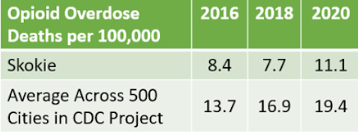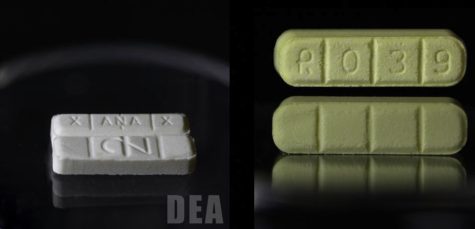AI generated image from Stockimg.ai.
Those Pills May Be Deadly: What You Should Know About Fentanyl and Common Pill Counterfeits
Feb 15, 2023
Fentanyl, a synthetic opioid that is 50 times stronger than heroin and 100 times more than morphine, is the deadliest drug that threatens the people of the United States today. Counterfeit prescription pills have been dominating the drug markets in America, fueling the current opioid epidemic.
Dealers have exploited the demand for prescription pills by creating cheap, yet deadly counterfeits. The DEA’s reports that common pills like Xanax, Adderall, etc have counterfeit pills made that are often cut with fentanyl to make them much more deadly. The equipment needed to mass-produce pills is also easily accessible, which increases the number of counterfeit pills being produced. Such easy access to synthetic opioids and to counterfeit pill presses has increased both production and availability of these drugs. The availability of fentanyl will continue to grow in the upcoming years because the easy access to the equipment used to manufacture counterfeit pills from both large cartels and small drug trafficking organizations.
This increase in drug production can be seen in every corner of the United States, though statistics in Skokie are low compared to the rest of the country.

According to a database created by the Centers for Disease Control and Prevention (CDC) that tracks different health factors in cities across the country. In 2020, Skokie ranked below the average number of deaths per overdose, at 11.1 deaths per 100,000 people.
“I’m not saying that we don’t have a problem, just that people, they’re not overdosing here in Skokie,” Liz Nelson, who works for the Skokie Health Department, said. “They’re not buying the drugs here, they tend to buy the drugs and then use them or take the drugs back to a party.”
As the epidemic continues, local organizations and non-profits work on prevention and education regarding potential overdoses and substance abuse. The PATH Crisis Center Resource Directory provides local youth and family service clinics that provide fentanyl test strips. Test strips are incredibly useful in finding fentanyl in pills, but they can only detect its presence, not the quantity. PATH also provides information and counseling resources targeted to specific zip codes and age groups.
Metropolitan Family Services, a non-profit serving the Chicago area, advocates for prevention education and attempts to destigmatize conversations around addiction.
“I would say that one of the biggest things is that I know [with] substance use, especially opioids and addiction and stuff like that, there are some major negative stigmas around the topic, which can make it kind of a taboo topic to talk about for sure. It makes people uncomfortable, they don’t really want to talk about it very often, but I think the best thing you can do is to talk about it to avoid the issue, cause really knowledge is totally power,” Substance Abuse Case Manager, Brenna Barry said.
Barry works on youth prevention education at local middle schools. Barry also works with Niles North’s Mental Health Club to promote messaging about the connection between mental health and substance abuse.
“I hate comparing [our programs] to D.A.R.E., but most of the time that gets people understanding what youth prevention education is. Luckily the field has made some major strides and is much more progressive now, so instead of having an officer teach it and use scare tactics, it’s definitely more like giving them the knowledge and teaching students peer pressure tactics, how to become more self-aware of their emotions and stuff, teaching them coping mechanisms, how to make healthy friendships and [how to] get out of unhealthy friendships or relationships in general. We’ll go over substance abuse and addiction as well,” Barry said.
Barry also stresses the importance of fighting the negative stigma around substance abuse and substance users.
“I think that a lot of people when they think of opioid addicts or any substance user, they have an image in their mind of what that person looks like, but truly it can happen to anyone,” Barry said. “Especially with the opioid crisis, I don’t think that people realize how severe the issue is and that it comes from a lot of different ways, it’s not just people making the choice to abuse a substance, it can happen from people who [have] even prescribed the substance, not realizing that they are using it incorrectly, or that if they do misuse their medication, they have a very high possibility of becoming addicted to it. [W]e should be empathetic when it comes to [this] issue.”
The Skokie Police Department treats overdose calls as a medical emergency, not as a criminal offense. Officers are trained to recognize the signs of an overdose and how to stop the effects using Naloxone, which every officer on patrol carries. Naloxone is a medication that stops the effects of an overdose through a nasal injection.
According to Crime Prevention and Community Relations Officer Rich Wilken, the opioid epidemic affects people of all ages and backgrounds.
“It’s everyone. I’ve been to calls where people that would have no other association with each other in life other than drug use are using together,” Wilken said. “[H]igh school students that are with middle-aged people that are practically homeless–the only association they have with each other is the drug. People will do a lot to get this drug once they get hooked on it. I think, in young people, a lot of the opioid abuse happens from experimenting with prescription opioids that are found, so painkillers that might be prescribed to somebody else, but then at one point it became fashionable for young adults to try drugs that aren’t prescribed to them. Then you combine those with alcohol, it creates some nasty effects.”
As an officer who responds to calls, Wilken has encountered people whose casual drug used escalated into addiction, and in some cases, overdose and death.
“This can alter a lot of people’s lives, I’ve been to calls before where people have passed away because of their opioid addiction, and it started as simple as using party drugs and then using prescription painkillers that maybe were prescribed to somebody in their home that they took. It can easily move from taking painkillers here and there into an addiction. People that are addicted are constantly chasing that high, and then it starts affecting life,” Wilken said.
With the current epidemic, it is important to be able to tell the differences between fake and authentic pills. The DEA’s One Pill Can Kill initiative shows pictures of actual pills, like Xanax, Oxycodone and Adderall, alongside their counterfeits.

These fake pills are often laced with fentanyl and carry with them a higher risk of overdose. They are made to look like their real counterparts.
The online aspect of buying pills stretches the outreach of these drugs to minors. Brightly colored pills are used to attract minors because they look like candy. There is suspicion but no evidence that brightly colored pills are more dangerous. Fentanyl-laced drugs have been confiscated in 26 states in multiple different forms, including pills, powder and blocks that resemble sidewalk chalk.
A high percentage of deaths in adults are from opioid overdoses. The CDC reports that the leading causes of death for adults are heart disease and cancer, but overdoses are on the rise nationwide.
Illegal drug use is also at its highest due to easy accessibility. A global supply chain fuels the current epidemic. Powdered fentanyl is purchased from China by traffickers, which is then smuggled into the United States and Mexico where it is pressed into pills and sold on the market. The Drug Enforcement Agency (DEA) tracks pill presses imported into the United States, but the fentanyl-laced pills are often mislabeled to avoid detection.
In order to combat rising overdose numbers nationally, fentanyl test strips are being used on city streets to test those drugs on the market. Effectiveness depends on the user, as it is recommended that each pill is tested because one pill may show up negative yet another from the same batch is positive. Dealers are also encouraged to test the pills themselves or provide strips to buyers, since they may be unknowingly selling fentanyl-laced counterfeits.
The city of Chicago has been combating the rising overdose rates by stationing boxes with doses of naloxone in front of libraries across the city. There are currently 51 boxes across the city. 77,000 test strips have also been administered since Oct. 2021 to help users test for fentanyl in drugs they buy.
Cook County confirmed a minimum of 1,599 deaths from opioids in 2022. The website said that the county office was still waiting for toxicology tests at the time the information was released. It is predicted that the total number of deaths will surpass 2,000. In 2021, Cook County had 1,936 opioid-related deaths.
